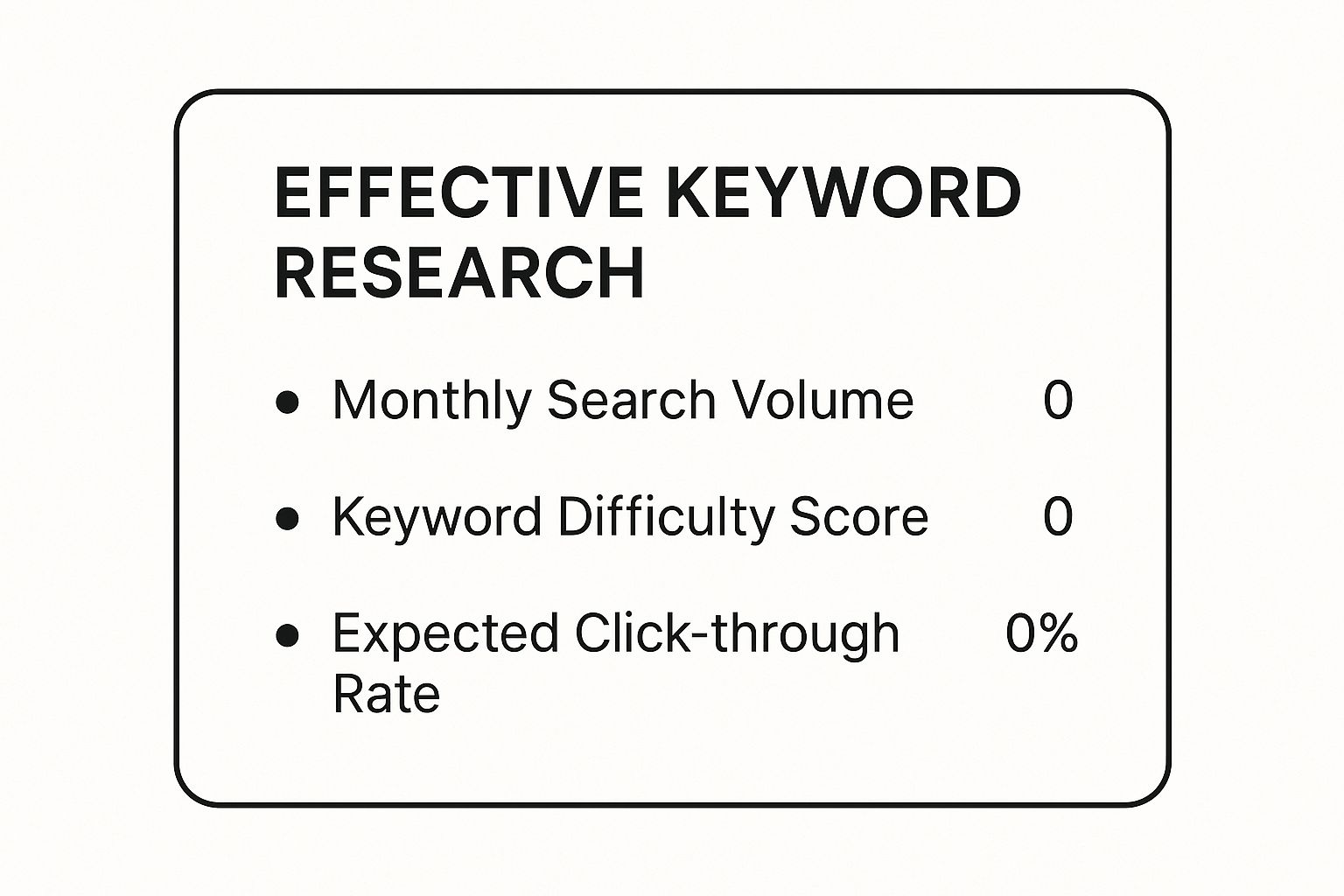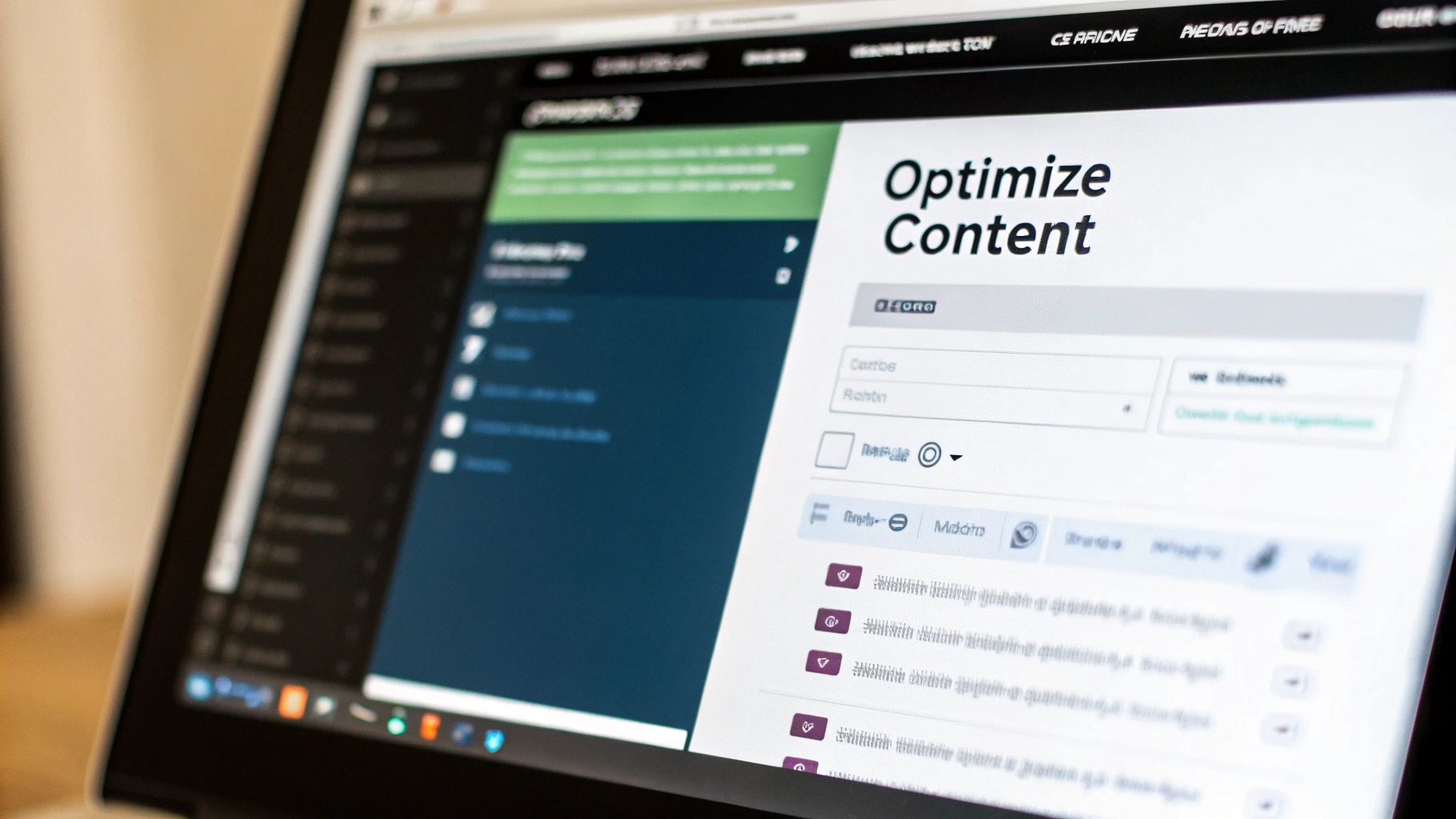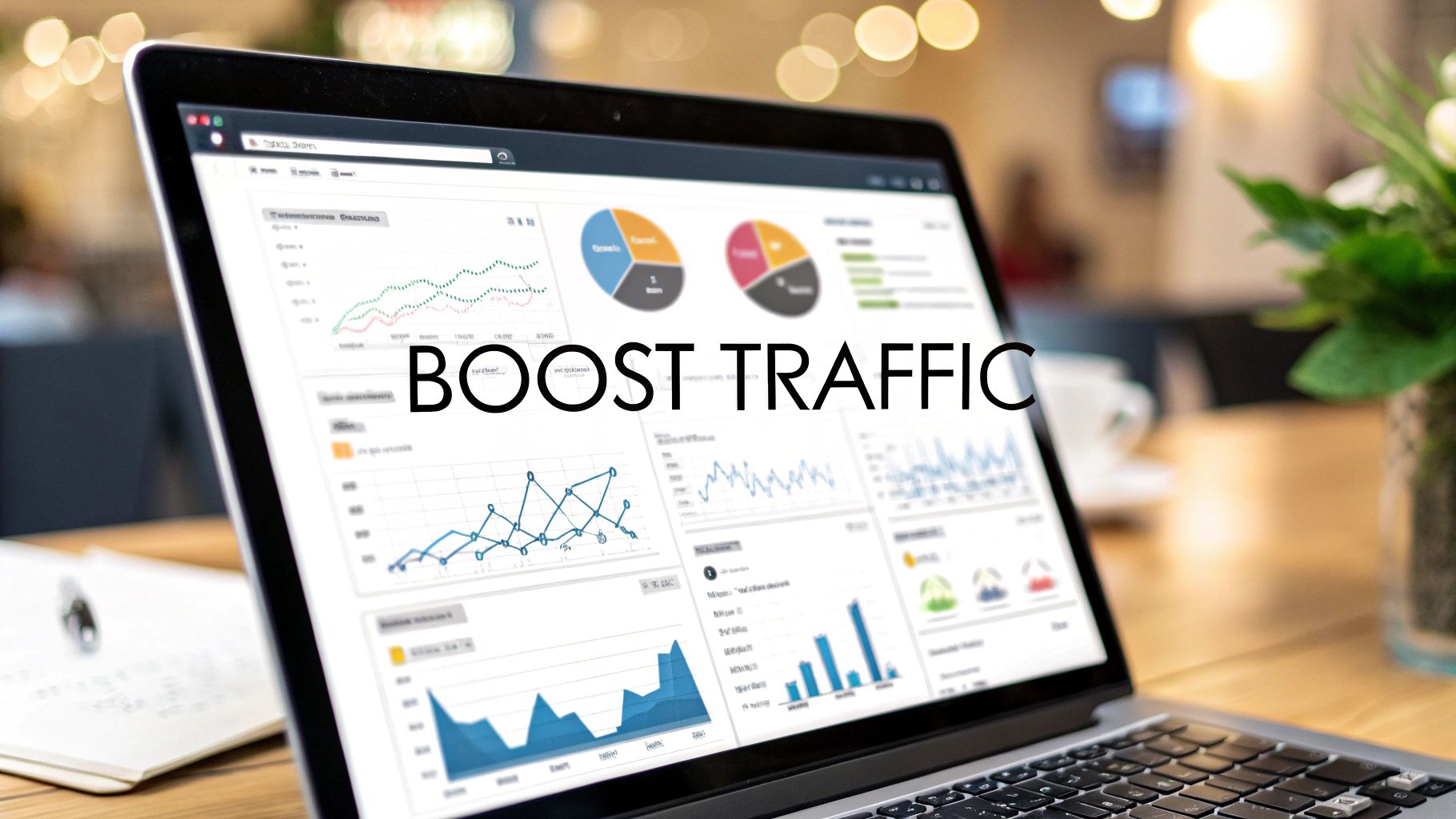Getting more people to visit your website isn't about finding a magic bullet. It’s a bit of a craft, really. You’re building a system where several moving parts work together: think search engine optimisation (SEO) to get found, high-quality content to keep people engaged, and smart promotion to spread the word.
The goal is to create a reliable engine that consistently brings the right kind of audience to your digital doorstep.
Your Framework for Sustainable Traffic Growth
Before we get into the nitty-gritty, let's zoom out and look at the big picture. Chasing after single tactics or 'hacks' is a surefire way to get burnt out with little to show for it. What you really need is a solid framework – a blueprint that guides your efforts and makes them count.
This guide is built around four core pillars. When you get these working in harmony, they create a powerful momentum that feeds itself. Each pillar supports the others, turning your website into a growth machine. For a broader look at different methods, this post on comprehensive strategies to bring traffic to your site offers some great foundational context.
To help you visualise how these elements fit together, here’s a quick summary of the core strategies.
Core Pillars of Website Traffic Growth
This table breaks down the main strategies we'll be covering, what you're trying to achieve with each, and how you'll know if you're succeeding.
| Strategy Pillar | Primary Goal | Key Actions | Measurement of Success |
|---|---|---|---|
| Search Visibility | Appear on the first page of search results for relevant queries. | Keyword research, on-page SEO, link building. | Higher organic rankings, increased organic traffic. |
| Content that Connects | Become a trusted authority that solves your audience's problems. | Writing blog posts, creating guides, producing videos. | Longer time on page, lower bounce rate, more return visitors. |
| Message Amplification | Proactively distribute your content to a wider audience. | Social media sharing, email marketing, outreach. | Increased referral traffic, social engagement, email sign-ups. |
| Technical Foundation | Provide a fast, secure, and user-friendly website experience. | Optimising site speed, ensuring mobile-friendliness, fixing errors. | Improved Core Web Vitals, lower bounce rates. |
Treat this table as your strategic cheatsheet. It's a reminder that every action should have a clear purpose and a measurable outcome.
The Four Pillars of Traffic Generation
Let's break down what each of these pillars actually involves. Getting a handle on these four areas is the difference between simply getting more clicks and attracting visitors who are genuinely interested in what you have to offer, especially if you're operating in the competitive UK market.
-
Mastering Search Visibility: At its heart, this is about making it incredibly easy for people to find you on search engines like Google. It starts with getting inside the heads of your potential UK customers to understand exactly what they're typing into that search bar, then optimising your site to show up for those queries.
-
Creating Content That Connects: Getting someone to click is only half the battle. Once they land on your site, you need something that grabs their attention, genuinely helps them, and makes them want to stick around. This is where you become the go-to resource in your field.
-
Amplifying Your Message: Hitting 'publish' on a brilliant piece of content is just the beginning. You have to actively get it out there. This means sharing it on the right social channels, building an email list you can talk to directly, and connecting with other influential voices in your industry.
-
Ensuring a Flawless Technical Foundation: None of the above matters if your website is slow, clunky, or broken on a mobile phone. A poor technical experience can sink all your other efforts in an instant by frustrating visitors and sending them straight to the back button.
Prioritising Your Efforts for Real Results
Let's be realistic – you don't have unlimited time or budget. The key is to focus on the actions that will give you the most bang for your buck. One of the very first things to tackle under the 'Search Visibility' pillar is smart keyword research. This isn't just about finding search terms; it's about understanding the intent behind them and, crucially, how hard they'll be to rank for.
This infographic breaks down the three data points you need to juggle for any keyword you're considering: Monthly Search Volume, Keyword Difficulty, and the potential Click-Through Rate you might expect.

It’s all about finding the sweet spot. A keyword with huge search volume is useless if the difficulty score is so high that your site has no chance of ranking for it in the near future. This is why a targeted, strategic approach is absolutely essential.
Master SEO to Capture High-Intent Visitors

When it comes to getting consistent, long-term traffic to your website, Search Engine Optimisation (SEO) is the engine room. Think of it as the art and science of making sure your business shows up when a potential customer is actively looking for the very solutions you provide. This isn't about some abstract theory; good SEO is built on practical, repeatable actions that get you noticed.
For any UK business, getting a grip on SEO isn't just a nice-to-have, it's essential. Why? Because Google basically is the internet for most people here. As of April 2024, Google holds a staggering 90.7% of the UK's search market. Not showing up on Google is like having a shop on the high street with the shutters permanently down. You can dig deeper into the UK's digital habits on DataReportal.
Find What Your Customers Are Really Searching For
The foundation of any good SEO strategy is smart keyword research. This goes way beyond just guessing what people might type into Google. It's about digging in and finding the exact phrases your ideal customers use when they're ready to research, compare options, or make a purchase.
So many businesses fall into the trap of chasing broad, incredibly competitive keywords. Imagine a small bakery in Norfolk trying to rank for "cakes." While it gets a ton of searches, the competition is fierce, and the audience is all over the place. A much smarter approach is to target long-tail keywords.
These are the longer, more specific phrases that tell you exactly what the searcher wants. Instead of "cakes," think "vegan birthday cake delivery Norwich" or "best sourdough bread in Diss." People using these terms know precisely what they're looking for, making them far more likely to convert.
Pro Tip: Your best keywords are often hiding in plain sight—in the questions your customers are already asking you. Look at your emails, listen to your phone calls. Every query is a potential keyword goldmine. Tools like AnswerThePublic can be brilliant for uncovering these question-based searches.
Craft On-Page Elements That Demand a Click
Once you've got your keywords, it's time to weave them into your website pages. This is what we call on-page SEO. It’s all about sending clear signals to both search engines and human visitors about what your content is about.
Pay close attention to these key on-page elements:
- Title Tags: This is the blue, clickable headline in the search results. It needs to include your main keyword, but just as importantly, it has to be compelling enough to earn the click.
- Meta Descriptions: That little snippet of text under the title. It doesn't directly influence your ranking, but a well-written one acts like a mini-advert for your page, dramatically improving your click-through rate.
- Headings (H1, H2, H3): Using headings to structure your content isn't just for looks. It breaks up the text, making it easier for people to scan and read, and it helps Google understand the hierarchy and topics you're covering.
Getting these fundamentals wrong can sabotage all your other efforts. If you want to be sure you're on the right track, check out our guide on the common mistakes in SEO and how to avoid them. A big part of this process involves a solid content gap analysis to spot what your competitors are ranking for that you aren’t.
Build Authority with Quality Backlinks
A backlink is just a link from another website pointing to yours. In Google's eyes, these are votes of confidence. When a relevant and reputable site links to you, it tells Google that your content is trustworthy and authoritative, which can give your rankings a serious boost.
The two most important words there are reputable and relevant. For that Norfolk bakery, a link from a local business directory is worth far more than a random link from an unrelated blog on the other side of the world. Building a strong backlink profile is a long game, so be patient. The best strategy? Focus on creating content so genuinely useful that other websites feel compelled to link to it.
Create Content That Attracts and Engages

Getting people to your website through SEO is a massive win, but that's only half the battle. What really convinces them to stick around, click through, and keep coming back is exceptional content. It’s time to go beyond the tired advice of "write good content" and build a proper system for creating articles that genuinely help people.
The aim here is to produce content so valuable that it becomes a traffic-driving asset all on its own. The kind of stuff that earns shares, comments, and those precious backlinks without you even having to ask.
Brainstorming Topics That Actually Help
Your best content ideas won't come from staring blankly at a keyword tool. They come from a deep understanding of the real-world problems your audience is trying to solve. A great place to start is simply by listening to the questions your customers ask you every single day.
Think about it: every email, phone call, or customer chat is a potential blog post. If one person has that question, you can bet dozens, if not hundreds, of others are typing the very same thing into Google.
Here are a few prompts to get you started:
- Common Roadblocks: What are the top three hurdles your customers face before they can buy from you?
- Frequent Questions: What's the one thing your sales team gets asked on almost every call?
- Industry Myths: What's a common misconception in your field that you're always having to correct?
Answering these turns your website into a genuinely helpful resource, not just another sales pitch. This builds trust and authority. For instance, if you're a Norfolk-based business, addressing local concerns can be a powerful way to connect. You can find out more about fine-tuning your online presence in our guide to search engine optimisation in Norfolk.
Here's a simple rule I always stick to: Solve, don't just sell. If you focus on helping the reader, the traffic and leads will naturally follow.
Build Topical Authority with the Hub and Spoke Model
Instead of publishing random, one-off blog posts, you'll see much better results by building topical authority. A brilliant strategy for this is the hub and spoke model. It's easy to picture if you think of a bicycle wheel.
The hub is your big, comprehensive guide on a broad topic central to what you do. So, if you're a web design agency, a hub page could be "The Ultimate Guide to Small Business Websites."
Then you have the spokes. These are shorter, more focused articles that dive into specific sub-topics and link back to your main hub. Examples might include "How to Choose the Right Domain Name," "5 Signs You Need a Website Redesign," or "Best E-commerce Platforms for UK Startups."
This structure is smart for two reasons:
- It keeps people on your site longer. They might land on a specific 'spoke' article from a search, and you can then guide them to the main 'hub' and other related posts, increasing their engagement.
- It signals expertise to Google. By creating an interlinked cluster of content, you're showing search engines that you have deep knowledge on a subject. This can boost the rankings for every single article in that cluster.
Mix Up Your Content Formats
Let's be honest, not everyone has the patience to read a 3,000-word guide. Your audience is made up of different people with different preferences, so your content should reflect that. Offering a variety of formats is a simple way to widen your appeal and keep things interesting.
Content Formats to Consider
| Format Type | Best Used For | Why It Works |
|---|---|---|
| In-depth Guides | Covering a broad topic from A to Z (your hub content). | Establishes you as the go-to expert and attracts backlinks from others wanting to cite a definitive resource. |
| Case Studies | Showcasing the real-world results you've delivered for clients. | Provides powerful social proof and helps potential customers imagine achieving similar success with you. |
| Checklists & Templates | Giving your audience a practical, actionable tool to use. | These are incredibly shareable and useful. People love resources that make their lives or jobs easier. |
| Comparison Posts | Weighing up two or more products, services, or strategies. | Catches people who are close to making a decision and are looking for that final bit of analysis to make their choice. |
This variety ensures you have something for everyone. For an even more extensive look at content types that bring in visitors time and time again, check out this ultimate list of evergreen content ideas to boost your website traffic. By mixing and matching these formats, you create a much richer and more engaging experience that encourages people to come back for more.
Get Your Content in Front of the Right People

Creating brilliant content is half the battle, but hitting ‘publish’ is far from the finish line. If you want to seriously increase your website traffic, you need a smart plan to get that content in front of the people who need to see it. After all, great content deserves an audience, but it rarely finds one on its own.
Think of promotion as the engine that drives your content. It’s what separates a blog post that gets a handful of clicks in its first week from one that keeps attracting new visitors for months, or even years. A solid promotion plan is how you make sure all your hard work actually pays off.
Choose the Right Platforms for Your UK Audience
Look, not all social media platforms are created equal. Trying to be everywhere at once is a classic mistake and a fast track to burning out. The key is to focus your efforts where your ideal customers actually hang out.
Think about who you’re selling to. If you’re a B2B firm in Norfolk providing IT solutions, your audience is almost certainly on LinkedIn, making professional decisions. But if you run a Suffolk-based shop selling handmade crafts, your visual products will shine on platforms like Instagram or Pinterest.
A tip from my own experience: Never just drop a link and run. You have to adapt your message for each platform. On LinkedIn, you might pull out an interesting statistic from your article and pose a thoughtful question. For Instagram, you could transform a key point into a sharp-looking graphic or a quick Reel. This extra bit of context makes a huge difference to your click-through rates.
Build Your Most Valuable Traffic Asset: An Email List
Social media is great for getting your name out there, but you’re building on borrowed ground. Algorithms change and platforms fall out of fashion. Your email list, on the other hand, is an asset you own outright. These subscribers are your core audience – people who’ve actively said, "Yes, I want to hear from you."
The goal here is simple: turn one-time visitors into loyal, repeat visitors. The best way to get people to sign up is by offering them something genuinely useful in return – what we call a lead magnet.
- A handy checklist: A simple, one-page PDF that helps your reader solve a specific problem.
- An exclusive template: For a B2B crowd, a project plan template or a budgeting spreadsheet works wonders.
- A free mini-course: A short series of automated emails teaching a valuable skill over a few days.
Once you start building that list, you can send out a regular newsletter to share your latest content, driving a reliable spike in traffic with every send. This is a fundamental part of any successful digital marketing plan because it builds real, lasting relationships. For a deeper dive, check out our post on why digital marketing is so important for boosting your business.
Tap into Existing Audiences with Smart Outreach
One of the fastest ways to get more traffic is to borrow someone else’s audience. This is where a bit of strategic outreach can work miracles.
Guest Posting
Writing for a respected blog in your industry is a time-tested and powerful tactic. The trick is to focus on delivering massive value to their readers, not just on snagging a link back to your own site. A single, well-written guest post on a relevant UK industry blog can send a steady stream of high-quality traffic your way for a long time.
Influencer Collaborations
This doesn’t mean you have to shell out thousands for a celebrity endorsement. Look for micro-influencers – these are the experts in your niche with smaller, but incredibly engaged, followings. You could co-create an article, feature them in an expert roundup post, or simply build a relationship by sharing their work. When they eventually share your content, it comes with a powerful stamp of approval for their dedicated followers.
Get Your Technical House in Order for a Better User Experience
You can pour all your energy into incredible content and slick promotion, but a clunky, slow, or confusing website can make all that effort for nothing. A wobbly technical foundation doesn't just annoy your visitors; it actively drives them away and tells search engines your site isn't up to scratch.
Think of it like this: you've built a beautiful shop with amazing products, but the front door is heavy and hard to open, the aisles are a maze, and the lights keep flickering. No one's going to stick around for long, no matter how good your stuff is. Your website is exactly the same.
Sorting out these core technical problems is a huge lever you can pull to increase website traffic. A seamless experience keeps people on your site longer, encourages them to click around, and signals to Google that you’re a quality result worth showing to more people.
Adopt a Mobile-First Mindset
In the UK, treating your mobile site as an afterthought is a recipe for failure. If you want to see your traffic numbers climb, you absolutely have to build for the smallest screen first. The stats don't lie: as of December 2023, a staggering 66.02% of all UK web traffic came from mobile devices. You can dive into the data yourself in this UK website usage report from Reboot Online.
Ignoring this isn't just bad practice; it's a direct hit to your search rankings. Google now operates on mobile-first indexing. This means it primarily looks at your mobile site to understand your content and decide where you belong in the search results. If your mobile experience is a clunky, stripped-down version of your desktop site, your visibility will suffer everywhere.
This screenshot from Google's own help documents really hammers the point home. The mobile version is what they see first.
This visual confirms it: Googlebot is almost always crawling the mobile version of a page. A top-notch mobile experience isn’t a nice-to-have; it's essential for SEO.
Speed Up Your Website
Website speed isn't some minor detail for the techies—it's a massive factor in keeping users happy and getting them to convert. We all expect pages to load in a blink. A delay of just a couple of seconds is often enough to make someone give up and head over to a competitor.
When it comes to how fast your site loads, every single second counts. Studies have shown that as page load time goes from just one second to three seconds, the chance of a visitor leaving shoots up by 32%.
Slow load times are usually down to a few common culprits. Here’s a quick checklist of things you can do right now to make your site faster:
- Shrink Your Images: Huge image files are one of the biggest speed killers. Use a tool like TinyPNG or ImageOptim to slash file sizes without making your photos look grainy.
- Invest in Good Hosting: Cheap hosting often turns out to be a false economy. As a Norfolk-based business, we’ve learned the value of solid infrastructure, which is why we use reliable UK-based servers at Ibertech for our clients. A good host is the foundation for a fast site.
- Use Browser Caching: Caching tells a visitor's browser to save parts of your site, like images and code. The next time they visit, the page loads much quicker because their device already has those files stored.
- Minify Your Code (CSS & JavaScript): This sounds technical, but it’s just a process of removing unnecessary characters (like spaces) from your site's code. It makes the files smaller and faster for a browser to download and read.
Secure Your Site with HTTPS
Online security is completely non-negotiable today. An HTTPS connection, shown by the little padlock in the browser's address bar, encrypts the data moving between your site and your visitor. This is crucial for protecting sensitive info like contact details or payment information.
Google has officially used HTTPS as a ranking signal for years. Perhaps more importantly, browsers like Chrome now slap a big "Not Secure" warning on any site that isn't using it. That warning can destroy a visitor's trust before they've even had a chance to read your first sentence.
If you haven't made the switch to HTTPS yet, make it your number one priority. Most good web hosts, including us, now offer free SSL certificates, so getting it sorted is often quite straightforward.
Measure What Matters to Fine-Tune Your Strategy
All the hard work you pour into SEO, content, and promotion doesn't mean much if you aren't tracking what's actually working. Flying blind is a fast track to burning through your budget and your energy. To genuinely grow your website traffic, you need to get comfortable with the data, understand what it's telling you, and let it shape your next move.
This is where a couple of free, incredibly powerful tools from Google come into play: Google Analytics 4 (GA4) and Google Search Console (GSC). I like to think of them this way: GSC gives you a window into how Google sees your site, while GA4 shows you what people actually do once they land there. Using them together gives you the complete story of your traffic.
Key Metrics to Keep an Eye On
It's ridiculously easy to get lost in a sea of data. The real skill is knowing which numbers matter—the ones that tell you a story and point towards your next action. Instead of getting hung up on every single metric, focus on these vital few. They'll give you a clear read on the health of your strategy and show you where your biggest growth opportunities are hiding.
Here’s what I recommend monitoring regularly:
- Organic Traffic Sources: This is your bread and butter. How many visitors are finding you through search engines like Google? A steady climb here is the clearest sign your SEO efforts are bearing fruit.
- Top-Performing Pages: Pop into GA4 and see which articles and landing pages are pulling in the most visitors. These are your proven winners. The next step is to dig into why they’re so popular and figure out how to replicate that magic elsewhere.
- User Engagement: Look at metrics like engaged sessions and average engagement time. These are far more insightful than old-school bounce rates. They tell you if people are genuinely sticking around to read your content or clicking away after a few seconds.
- Search Queries (in GSC): This report is an absolute goldmine. It reveals the exact phrases people are typing into Google to find you. You'll uncover fantastic new keyword ideas and see precisely how you’re ranking for your main targets.
Don't let this become a massive, daunting task. I've found that setting aside 30 minutes every Monday morning to review the previous week's performance is a game-changer. It builds a simple, consistent rhythm for making smart decisions, rather than letting it become an overwhelming quarterly chore.
Turning Your Data into Action
Alright, so you have the numbers. What now? The real value isn't in the data itself, but in how you interpret it to create a feedback loop that refines your strategy. It’s a constant cycle of looking at the results, forming a hypothesis, and taking action. This is what separates stagnant websites from those that achieve sustained growth.
My Go-To Performance Review Framework
I use a simple "If This, Then That" approach to turn data into a concrete to-do list.
| If You See This… | It Might Mean… | Your Next Action Should Be… |
|---|---|---|
| A blog post has high traffic but low engagement time. | The headline and meta description are doing their job, but the content isn't delivering on the promise. | Go back and rewrite the introduction to hook the reader faster. Add more visuals, break up long paragraphs, and use bold text to improve readability. |
| GSC shows you're ranking on page two for a valuable keyword. | You're so close! The page is relevant, but it just needs a bit more authority or optimisation to crack the first page. | Freshen up the content with the latest information, find more opportunities to internally link to it from other pages, and try to build a few high-quality backlinks. |
| A page has lots of traffic from a single referral source. | You've caught someone's eye! Another website has mentioned or linked to you. | Don't let that opportunity go to waste. Reach out to the site owner to say thank you and explore if there's a chance to collaborate—perhaps on a guest post or a co-hosted webinar. |
By regularly reviewing what’s working, what’s falling flat, and where your best opportunities are, you shift from guesswork to a deliberate, repeatable process for growth. This is how you build a website that doesn't just get traffic, but gets the right traffic, month after month.
Your Questions, Answered
Even with the best roadmap, a few questions always pop up along the way. I get it. Let's tackle some of the most common ones I hear about boosting website traffic so you can move forward with confidence.
How Long Until I Actually See More Traffic?
This is the big one, isn't it? The honest answer is: it depends, but patience is your best friend, especially with SEO.
If you’re running paid ads, you can see new visitors arriving almost instantly. But for the organic, long-term growth that comes from search engines, you're playing a different game. For a brand-new website, you should realistically expect it to take 6 to 12 months before you see significant, consistent traffic flowing from your SEO work.
Content and social media can offer quicker wins. A fantastic blog post that you promote heavily might create a nice spike in visitors within a few days. The real aim, though, is to build a library of content that becomes a reliable, traffic-generating asset for months and years to come.
Think of it this way: sustainable traffic growth is a marathon, not a sprint. Don't get discouraged after a few weeks. Keep putting in the work, creating and promoting, and you'll see the results compound over time.
Should I Pour My Budget into Paid Ads or Focus on Free Traffic?
The most effective strategy almost always uses a bit of both. They play different roles but complement each other perfectly.
-
Free (Organic) Traffic: This is the bedrock of your online presence. Things like SEO and content marketing are about building genuine authority and trust. It's an investment of your time that pays off by delivering a steady stream of high-quality visitors without you paying for every single click.
-
Paid Traffic: Think of this as your accelerator pedal. Paid ads on Google or social media are brilliant for getting in front of a very specific audience, quickly testing a new product, or funnelling people to a critical landing page. You get immediate data and can see what works right away.
A really smart way to start is by using paid campaigns to get that initial burst of traffic and feedback. While that’s happening, you can be working on your long-term organic strategy in the background, letting it build momentum.
How Often Do I Really Need to Publish New Content?
Consistency will always beat frequency. It's far better to publish one incredibly helpful, well-researched article every week than to churn out three thin, rushed posts that don't really help anyone. The goal is to create content that genuinely solves a problem for your reader.
When you're just starting out, aiming for one to two in-depth posts a week is a great target. It's enough to keep your site fresh, signal to search engines that you're active, and give you new material to share, all without completely burning you out. Always remember: quality over quantity.
Ready to stop guessing and start growing? The team at Ibertech Solutions Limited specialises in creating bespoke web design and digital marketing strategies that drive real results for businesses in Norfolk and Suffolk. From expert SEO to engaging content, we build the online presence you need. Visit us online for a free audit and see how we can help you increase website traffic today.





